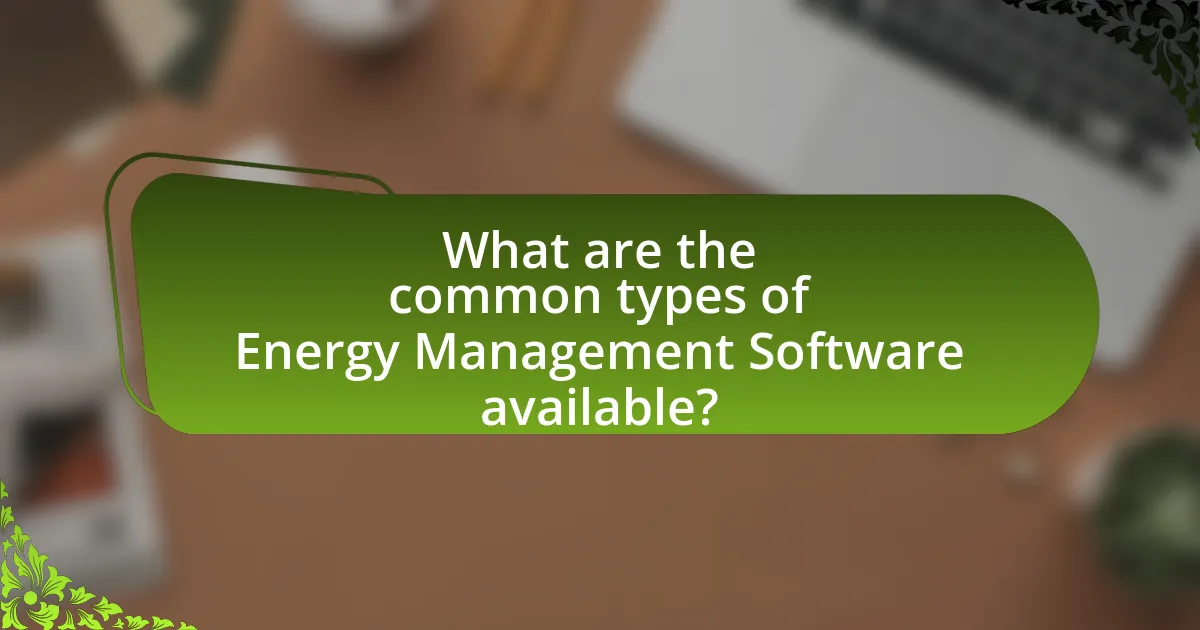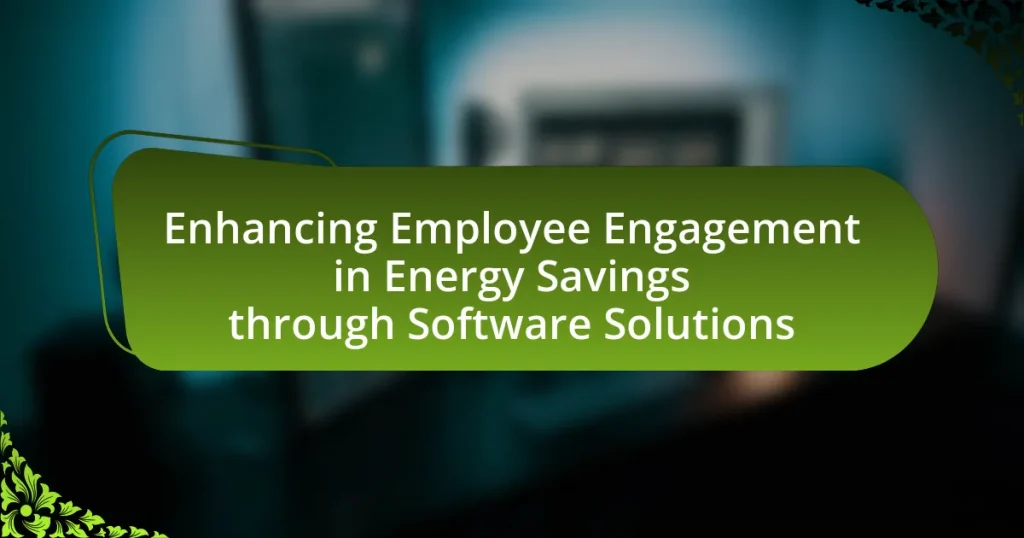Energy Management Software is a digital tool that helps organizations monitor, control, and optimize energy consumption in buildings and facilities, leading to significant cost savings and sustainability improvements. The article outlines the functionality, key features, and importance of this software for businesses, emphasizing its role in enhancing energy efficiency and reducing operational costs. It also discusses factors to consider when selecting Energy Management Software, including scalability, user experience, and integration capabilities, while highlighting common types available in the market. Additionally, the article provides guidance on effective implementation, best practices post-implementation, and metrics for measuring success, ensuring businesses can make informed decisions to achieve their energy management goals.

What is Energy Management Software?
Energy Management Software is a digital tool designed to monitor, control, and optimize energy consumption in buildings and facilities. This software enables organizations to track energy usage patterns, identify inefficiencies, and implement strategies for reducing energy costs and environmental impact. According to a report by the U.S. Department of Energy, effective energy management can lead to energy savings of 10% to 30% in commercial buildings, demonstrating the software’s potential for significant cost reduction and sustainability improvements.
How does Energy Management Software function?
Energy Management Software functions by collecting, analyzing, and reporting energy consumption data to optimize energy use and reduce costs. This software integrates with various energy sources and systems, such as smart meters and building management systems, to gather real-time data on energy usage patterns. By employing algorithms and analytics, it identifies inefficiencies and suggests actionable insights for energy savings. For instance, a study by the U.S. Department of Energy found that implementing energy management systems can lead to energy savings of 10-30% in commercial buildings, demonstrating the effectiveness of such software in enhancing energy efficiency.
What are the key features of Energy Management Software?
Energy Management Software typically includes features such as real-time energy monitoring, data analytics, reporting capabilities, and integration with building management systems. Real-time energy monitoring allows businesses to track energy consumption continuously, enabling immediate identification of inefficiencies. Data analytics provides insights into usage patterns, helping organizations make informed decisions to optimize energy use. Reporting capabilities facilitate compliance with regulations and support sustainability initiatives by generating detailed reports on energy performance. Integration with building management systems enhances operational efficiency by allowing for automated control of energy systems. These features collectively contribute to improved energy efficiency and cost savings for businesses.
How do these features contribute to energy efficiency?
Energy management software features contribute to energy efficiency by enabling real-time monitoring and analysis of energy consumption patterns. These features allow businesses to identify inefficiencies, optimize usage, and implement targeted strategies for reduction. For instance, advanced analytics can reveal peak usage times, enabling companies to shift energy-intensive operations to off-peak hours, thus lowering costs and reducing strain on the energy grid. Additionally, automated alerts for unusual consumption can prompt immediate corrective actions, further enhancing efficiency. Studies show that organizations utilizing energy management software can achieve energy savings of 10-30%, demonstrating the tangible impact of these features on overall energy efficiency.
Why is Energy Management Software important for businesses?
Energy Management Software is important for businesses because it enables efficient monitoring and control of energy consumption, leading to cost savings and sustainability. By utilizing this software, companies can identify energy usage patterns, optimize resource allocation, and reduce waste. For instance, a study by the U.S. Department of Energy found that organizations implementing energy management systems can achieve energy savings of 10% to 30%. This not only lowers operational costs but also enhances corporate responsibility by minimizing environmental impact.
What are the potential cost savings associated with Energy Management Software?
Energy Management Software can lead to significant cost savings by optimizing energy consumption and reducing waste. Businesses utilizing this software often experience reductions in energy costs by 10% to 30%, as reported by the U.S. Department of Energy. Additionally, the software enables better demand response strategies, which can further decrease peak energy charges. By providing real-time data analytics, Energy Management Software helps identify inefficiencies and implement corrective measures, resulting in lower operational costs and improved energy efficiency.
How does Energy Management Software support sustainability goals?
Energy Management Software supports sustainability goals by optimizing energy consumption and reducing waste. This software enables organizations to monitor real-time energy usage, identify inefficiencies, and implement strategies for energy conservation. For instance, a study by the U.S. Department of Energy found that effective energy management practices can lead to energy savings of 10-30%, significantly lowering carbon emissions. By providing actionable insights and facilitating data-driven decision-making, Energy Management Software plays a crucial role in helping businesses achieve their sustainability objectives.

What factors should you consider when choosing Energy Management Software?
When choosing Energy Management Software, consider functionality, integration capabilities, user-friendliness, scalability, and cost. Functionality ensures the software meets specific energy management needs, such as monitoring, reporting, and analytics. Integration capabilities are crucial for seamless operation with existing systems like building management or utility billing. User-friendliness affects adoption rates among staff, while scalability allows the software to grow with your business. Cost should align with your budget while providing a clear return on investment through energy savings and efficiency improvements. These factors collectively ensure that the chosen software effectively supports your energy management goals.
How do your business needs influence your choice of Energy Management Software?
Business needs significantly influence the choice of Energy Management Software by determining the specific features and functionalities required to optimize energy usage. For instance, a company focused on reducing operational costs may prioritize software that offers detailed analytics and reporting capabilities to identify energy inefficiencies. Additionally, businesses with sustainability goals may seek software that supports renewable energy integration and carbon footprint tracking. According to a study by the International Energy Agency, organizations that align their energy management strategies with their business objectives can achieve energy savings of up to 20%. Thus, understanding unique business requirements is crucial for selecting the most effective Energy Management Software.
What specific functionalities should you look for based on your industry?
When selecting energy management software, specific functionalities to look for include real-time energy monitoring, data analytics, and reporting capabilities tailored to your industry. Real-time energy monitoring allows businesses to track energy consumption patterns, which is crucial for industries like manufacturing, where energy efficiency can significantly impact operational costs. Data analytics features enable users to identify trends and anomalies in energy usage, facilitating informed decision-making. Reporting capabilities should align with industry regulations and standards, ensuring compliance and providing insights for continuous improvement. For example, the manufacturing sector often requires detailed reports on energy usage to meet sustainability goals and regulatory requirements.
How can scalability impact your software selection?
Scalability significantly impacts software selection by determining whether the software can grow alongside the business. When a company anticipates growth, selecting scalable software ensures that it can handle increased data loads, user demands, and additional features without requiring a complete overhaul. For instance, a study by Gartner indicates that 70% of organizations face challenges with software scalability, which can lead to increased costs and operational inefficiencies. Therefore, choosing software that can scale effectively is crucial for long-term sustainability and cost management in energy management systems.
What role does user experience play in selecting Energy Management Software?
User experience plays a critical role in selecting Energy Management Software as it directly influences user adoption and satisfaction. A well-designed interface enhances usability, allowing users to navigate the software efficiently and access essential features without frustration. Research indicates that software with a positive user experience can lead to a 50% increase in user engagement and productivity, as users are more likely to utilize tools that are intuitive and easy to use. Therefore, prioritizing user experience in the selection process ensures that the software meets the needs of its users, ultimately leading to better energy management outcomes.
How important is the software’s interface and usability?
The software’s interface and usability are critically important for effective user engagement and operational efficiency. A well-designed interface enhances user experience, reduces training time, and minimizes errors, leading to increased productivity. Research indicates that 70% of users abandon software due to poor usability, highlighting the necessity for intuitive design. Furthermore, a study by the Nielsen Norman Group found that users are more likely to adopt software that is easy to navigate, which directly impacts the software’s overall success in a business context.
What training and support options should you consider?
When selecting energy management software, consider training options such as vendor-led training sessions, online tutorials, and user manuals. These resources help users understand software functionalities and maximize its benefits. Additionally, support options like 24/7 customer service, community forums, and dedicated account managers provide ongoing assistance and troubleshooting. Research indicates that companies utilizing comprehensive training and support experience a 30% increase in software adoption rates, enhancing overall operational efficiency.

What are the common types of Energy Management Software available?
Common types of Energy Management Software include Energy Monitoring Systems, Building Energy Management Systems (BEMS), Utility Bill Management Software, and Demand Response Management Systems. Energy Monitoring Systems track real-time energy consumption and provide analytics for optimization. Building Energy Management Systems integrate various building systems to enhance energy efficiency and reduce costs. Utility Bill Management Software automates the tracking and analysis of utility bills to identify discrepancies and savings opportunities. Demand Response Management Systems facilitate the adjustment of energy usage during peak demand periods, helping businesses save on energy costs. These software types are essential for businesses aiming to improve energy efficiency and reduce operational costs.
What are the differences between cloud-based and on-premise Energy Management Software?
Cloud-based Energy Management Software operates on remote servers accessed via the internet, while on-premise Energy Management Software is installed locally on a company’s own servers. Cloud-based solutions offer scalability, automatic updates, and remote access, making them more flexible and often more cost-effective for businesses. In contrast, on-premise solutions provide greater control over data security and customization but require significant upfront investment and ongoing maintenance. According to a report by Gartner, 70% of organizations are expected to adopt cloud-based solutions by 2025, highlighting the growing preference for cloud technology in energy management.
What are the advantages and disadvantages of each type?
The advantages of cloud-based energy management software include accessibility from any location, scalability, and lower upfront costs, while disadvantages may involve data security concerns and reliance on internet connectivity. On the other hand, on-premises energy management software offers enhanced data control and security, but it typically requires higher initial investment and ongoing maintenance costs. Each type presents unique benefits and challenges that businesses must weigh based on their specific needs and resources.
How does deployment method affect your business operations?
The deployment method significantly impacts business operations by influencing scalability, accessibility, and cost-effectiveness. For instance, cloud-based deployment allows for real-time data access and collaboration across multiple locations, enhancing operational efficiency. In contrast, on-premises deployment may limit accessibility and require higher upfront costs for hardware and maintenance. According to a report by Gartner, organizations that adopt cloud solutions can reduce IT costs by up to 30%, demonstrating the financial benefits of choosing the right deployment method.
What are some popular Energy Management Software solutions on the market?
Some popular Energy Management Software solutions on the market include Energy Star Portfolio Manager, Schneider Electric’s EcoStruxure, and Siemens’ Desigo CC. Energy Star Portfolio Manager is widely used for benchmarking energy performance and tracking energy consumption across various facilities. Schneider Electric’s EcoStruxure offers comprehensive energy management and automation solutions, enabling businesses to optimize their energy usage. Siemens’ Desigo CC integrates building management systems for efficient energy monitoring and control. These solutions are recognized for their effectiveness in helping organizations manage energy consumption and reduce costs.
What features do leading Energy Management Software solutions offer?
Leading Energy Management Software solutions offer features such as real-time energy monitoring, data analytics, reporting capabilities, and integration with renewable energy sources. Real-time energy monitoring allows businesses to track energy consumption instantly, enabling immediate adjustments to reduce costs. Data analytics provides insights into usage patterns, helping organizations identify inefficiencies and optimize energy use. Reporting capabilities facilitate compliance with regulations and support sustainability initiatives by generating detailed reports on energy performance. Integration with renewable energy sources enhances the software’s functionality by allowing users to manage and optimize energy from solar, wind, or other renewable systems effectively. These features collectively empower businesses to improve energy efficiency and reduce operational costs.
How do pricing models vary among different software providers?
Pricing models among different software providers vary significantly, reflecting diverse strategies and market segments. For instance, some providers adopt a subscription-based model, charging monthly or annual fees, which is common in SaaS (Software as a Service) offerings, allowing for predictable budgeting. Others may utilize a one-time licensing fee, where customers pay upfront for perpetual use, often seen in traditional software sales. Additionally, tiered pricing structures are prevalent, where features and support levels increase with higher-priced tiers, catering to varying customer needs and budgets. According to a 2022 report by Gartner, 70% of software providers now offer flexible pricing options to accommodate different business sizes and requirements, indicating a trend towards customization in pricing strategies.

How can you effectively implement Energy Management Software in your business?
To effectively implement Energy Management Software in your business, start by conducting a thorough assessment of your current energy usage and needs. This assessment will help identify specific areas where the software can provide the most value, such as monitoring consumption patterns or optimizing energy efficiency. Next, select a software solution that aligns with your business objectives and integrates seamlessly with existing systems. Training staff on the software’s functionalities is crucial for maximizing its benefits, as well as establishing clear goals and metrics to measure performance improvements. According to a study by the U.S. Department of Energy, businesses that actively engage in energy management can reduce energy costs by 10-30%, demonstrating the tangible benefits of effective software implementation.
What steps should you take for a successful implementation?
To achieve a successful implementation of energy management software, first, conduct a thorough needs assessment to identify specific business requirements. This assessment ensures that the selected software aligns with organizational goals and operational needs. Next, develop a detailed implementation plan that outlines timelines, responsibilities, and resource allocation. This structured approach facilitates coordination among team members and stakeholders.
Following the plan, ensure comprehensive training for all users to maximize software utilization and effectiveness. Training enhances user confidence and promotes adherence to new processes. Additionally, establish a feedback mechanism to monitor performance and address any issues promptly. This ongoing evaluation allows for adjustments and improvements, ensuring the software continues to meet evolving business needs.
Research indicates that organizations that follow a structured implementation process experience a 30% increase in software adoption rates, leading to improved energy management outcomes.
How can you ensure stakeholder buy-in during the implementation process?
To ensure stakeholder buy-in during the implementation process, actively involve stakeholders from the beginning by soliciting their input and addressing their concerns. Engaging stakeholders early fosters a sense of ownership and commitment to the project. Research indicates that projects with high stakeholder engagement have a 70% higher success rate, as seen in the Project Management Institute’s “Pulse of the Profession” report. Regular communication, transparent updates, and demonstrating how the energy management software aligns with their goals further solidify their support.
What are the common challenges faced during implementation?
Common challenges faced during implementation of energy management software include resistance to change, integration issues with existing systems, and inadequate training for staff. Resistance to change often arises from employees who are accustomed to traditional methods and may be hesitant to adopt new technology. Integration issues can occur when the new software does not seamlessly connect with legacy systems, leading to data silos and inefficiencies. Inadequate training can result in underutilization of the software’s features, as employees may not fully understand how to leverage the tool effectively. These challenges are frequently cited in industry reports, such as the 2021 Energy Management Software Market Analysis, which highlights that 60% of organizations experience integration difficulties during implementation.
What best practices should you follow post-implementation?
Post-implementation, businesses should prioritize continuous monitoring and evaluation of the energy management software’s performance. This involves regularly analyzing energy consumption data to identify trends and areas for improvement. Additionally, conducting user training sessions ensures that all team members are proficient in utilizing the software effectively, which enhances overall efficiency. Establishing a feedback loop with users allows for ongoing adjustments and improvements based on real-world usage. Furthermore, integrating the software with existing systems can streamline operations and enhance data accuracy. These practices are supported by studies indicating that organizations that actively engage in post-implementation reviews and training achieve up to 30% greater energy savings compared to those that do not.
How can you continuously optimize the use of Energy Management Software?
Continuously optimizing the use of Energy Management Software involves regularly analyzing energy consumption data and adjusting strategies based on insights gained. By implementing real-time monitoring and analytics, businesses can identify inefficiencies and areas for improvement. For instance, a study by the U.S. Department of Energy found that organizations using advanced energy management systems can reduce energy costs by 10-30%. Regularly updating software features and integrating user feedback also enhances functionality and user experience, ensuring that the software remains aligned with evolving energy management goals.
What metrics should you track to measure success?
To measure success in energy management software, track metrics such as energy consumption, cost savings, carbon footprint reduction, and return on investment (ROI). Energy consumption metrics provide insights into usage patterns, while cost savings quantify financial benefits achieved through efficiency improvements. Carbon footprint reduction metrics assess environmental impact, and ROI measures the financial return relative to the investment made in the software. These metrics are essential for evaluating the effectiveness of energy management strategies and ensuring alignment with business sustainability goals.
What tips can help you choose the right Energy Management Software for your business?
To choose the right Energy Management Software for your business, prioritize features that align with your specific energy management goals. Assess software capabilities such as real-time monitoring, data analytics, and reporting functionalities, as these are essential for effective energy management. Additionally, consider user-friendliness and integration with existing systems, as a seamless experience can enhance operational efficiency. Research customer reviews and case studies to validate the software’s effectiveness in similar business contexts, ensuring it meets industry standards and compliance requirements. Finally, evaluate the vendor’s support and training offerings, as ongoing assistance can significantly impact successful software implementation and usage.



